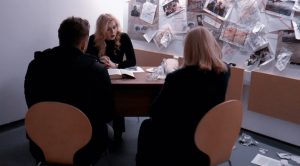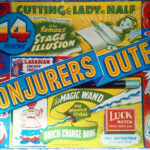The Mysterium* played the Sir Patrick Stewart Theatre a couple of weekends ago and was an experiment in devising using techniques drawn from analogue gaming and live action role playing (LARP). I had previously dipped my toes into these waters with Speaker’s Spooky Spaces (2015) which was another experiment in using semi-improvised LARP generated scenes to produce as semi-interactive experience for an audience. The process for the Mysterium differed from that of Speaker’s Spooky Spaces in that more techniques drawn from analogue gaming were used in the initial stages of story development and there was more of a steer to make the piece ludic for the audience.
The process began with developing a gaming mind-set through exploring techniques drawn from pervasive and immersive gaming including; Two Rooms and a Boom (Gerding & McCoy, 2013), Killer (Jackson, 1981), Spyfall (Ushan, 2014) and Morton’s List (Bruce et al., 2001). This served as providing the actors with a foundation with which to understand the nature of ludic devising and basic game theory.

From this we moved on to create the story of the game, The Mysterium. This devising process used Fiasco (Morningstar, 2009), Call of Cthulhu (Peterson, 1981), Fullerton’s ideas on Game Design (2008) and exercises drawn from LARP to devise the complex and often sprawling plot of a three volume novel that covers the period 1888 to 1970’s London. The novel follows the discovery of a substance capable of bestowing the user the power to see into the angles of time – see Lovecraft’s Hounds of Tindalos (1929) for further background to our initial inspiration. The purpose of this element was to provide a deep narrative that could be explored in the next phase.
From this point we stepped away from the process and began working anew as a theatre company attempting to adapt this epic novel for a 45-minute piece of immersive (we’re are still unsure if we like this term, but we’ll use it here), and hopefully ludic piece of theatre. The process of stepping away was a challenge as we had clear investment in the tale and the characters; this meant the process of adaptation was never at ‘arms length’, as we would have hoped.

This final stage involved adapting scenes, designing mini-games and a lot of lively ‘discussion’. The piece ran for approximately 40 minutes and had two possible endings depending of final audience choice. The sets included an orientation area where the players (a maximum of eight per show) could meet the GM and be prepped for the game; the Fortune-Teller’s room where the players were ‘sorted’; a main bar area that became the hub for the audience and where some scenes were played; one wall of the bar was a reveal gauze masking a performance area where scenes would appear and be played out; behind the other wall of the bar was a dressing room set, and a UV room; outside of the main space was a forest/potions area and a 1970s police office. These areas were used at different times for one-on-ones, interactive scenes or more ‘traditional’ non-interactive scenes. Clues were given throughout and the audience given various challenges before deciding on a final outcome.

On reflection the process of devising The Mysterium was a success in that it generated a great deal of narrative material, however challenges for game play remained. Some of these were due to venue restraints i.e. we had strict one-hour slots and this did not give the audience time to fully engage in discussions regarding the puzzles and clues; and others were due to late play testing. Test audiences in a project such as this are vital, and ours was very helpful and we incorporated what we could into the piece, but some elements did need revising (I’ll probably talk more about this in a later post).
So, with this in mind The Mysterium could be named The Mysterium v.1.1 or even The Mysterium v.1.1 (Beta) as there is now room for redevelopment and more exploration. Perhaps at this stage the gaming/interactive element needs to be explored more deeply and then reintroduced in a further process of devising. I hope that The Mysterium will return in some form in the near future. When it does I’ll write about it here.
*The title The Mysterium is derived from the board game of the same name, by Nevskiy & Sidorenko (2015)


Comments by Nik Taylor